Mold on Clothes: Complete Identification, Removal & Prevention Guide
Is Mold on Clothes Dangerous? Everything You Need to Know
Quick Answer: Mold can grow on clothes within 24-48 hours when exposed to moisture and poor ventilation. While some mold can be removed through proper washing techniques, certain types like black mold require professional assessment and may necessitate disposal of affected items.
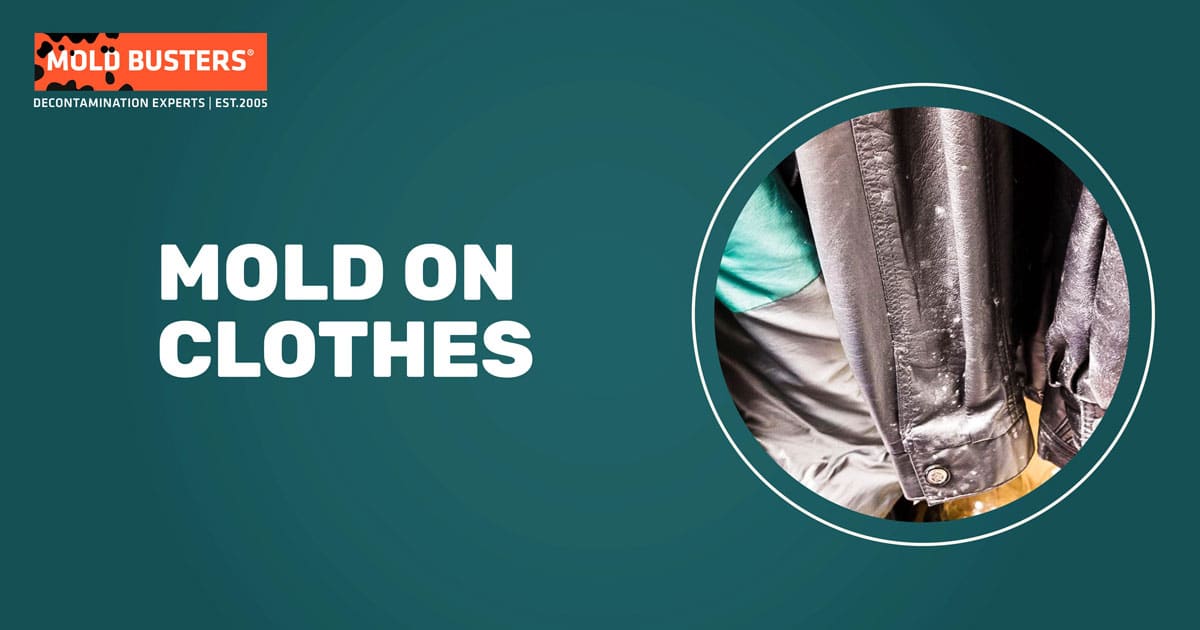
Visual identification guide for different mold types on clothing
Mold on clothes poses serious health risks including respiratory problems, skin irritation, and immune system compromise. This comprehensive guide, developed by Mold Busters’ certified specialists with over 15,000 inspections since 2005, provides expert-verified identification, removal, and prevention strategies for clothing mold issues.
Though most people associate mold with wall mold removal, it commonly appears on fabrics and clothing. Mold destroys materials it contacts while releasing harmful spores that can trigger serious health complications.

Professional mold identification on clothing fibers
⚠️ Worried About Mold on Clothes? Get a Free Inspection!
Mold on clothes indicates broader contamination issues requiring professional assessment. Our certified virtual mold inspection identifies hidden sources and provides comprehensive remediation strategies. Don’t risk your health – get expert evaluation today!
What Does Mold on Clothes Look Like?
Mold on clothes appears as discolored patches, spots, or fuzzy growth with distinct visual characteristics that help identify the specific type and contamination severity. Professional identification requires understanding color variations, texture differences, and growth patterns across different fabric types.
⚪ White Mold on Clothes
White mold appears as powdery, chalk-like spots that often resemble talcum powder or flour dusting. This white mold typically manifests as:
- Texture: Powdery, flaky surface that brushes off easily initially
- Location: Concentrated in fabric folds, seams, and storage contact points
- Progression: Starts small then spreads in irregular patterns
- Color changes: May shift to gray or yellow over time
⚫ Black Mold on Clothes
Black mold manifests as dark, often greenish-black patches with a slimy texture when moist and crusty appearance when dry. Black mold identification requires immediate professional assessment due to toxicity concerns.
- Appearance: Deep black or dark green discoloration
- Texture: Slimy when wet, brittle when dried
- Odor: Strong, musty, earth-like smell
- Health risk: Highest toxicity requiring immediate attention
Other Common Mold Colors
🟢 Green Mold
Green mold typically appears as blue-green fuzzy growth commonly found on natural fiber clothing stored in humid conditions. This green mold type often indicates prolonged moisture exposure and organic material breakdown.
🟤 Brown Mold
Brown mold presents as tan, chocolate, or reddish-brown patches frequently appearing on leather goods, wool items, and organic-treated fabrics. Brown mold identification requires careful examination as it’s often mistaken for staining.
🌈 Additional Mold Colors to Watch For
- Orange mold: Bright orange patches on synthetic fabrics
- Yellow mold: Yellowish discoloration on cotton and linen
- Pink mold: Rose-colored growth in bathroom textiles
How Can You Tell if Clothes Have Mold?
Professional mold detection on clothes combines visual inspection, odor assessment, and texture evaluation to determine contamination extent and health risk levels. Mold Busters’ certified technicians use proven identification protocols developed through thousands of residential inspections.
👃 Smell Detection
Mold on clothes produces a distinctive musty, earthy odor often described as damp basement or rotting wood smell. This characteristic mold odor indicates active spore production and requires immediate attention.
✋ Texture Changes
Moldy clothes feel damp, slimy, or unusually stiff compared to clean, dry garments. Texture changes indicate mold penetration into fabric fibers, making removal more challenging and potentially requiring professional treatment.
Visual Inspection Techniques
🔍 Professional Inspection Checklist
- Check fabric folds: Inspect seams, pockets, and collar areas
- Examine storage contact points: Areas touching hangers, shelves, or other clothes
- Look for discoloration: Any unusual spots or color changes
- Assess fabric integrity: Weak spots or holes indicating advanced damage
Why Does Mold Grow on Clothes?
Mold growth on clothes occurs when specific environmental conditions combine with organic material presence, creating ideal fungal development conditions. Understanding these factors helps prevent recurrence and guides effective treatment approaches.
🧬 Can Mold Grow on Fabric?
Yes, mold can grow on most clothing fabrics, particularly natural fibers like cotton, wool, and linen that provide organic nutrients. Synthetic fabrics resist mold growth but can support it when contaminated with body oils, dirt, or organic residues.
⏱️ Growth Timeline
Mold can begin growing on wet clothes within 24-48 hours under optimal conditions. Timeline factors include fabric type, moisture level, temperature, and contamination with organic matter. Natural fibers show faster colonization than synthetic materials.
Critical Growth Conditions
⚠️ Perfect Storm Conditions for Mold Growth
Mold grows on clothes when moisture, warmth, and organic matter combine in poorly ventilated environments. Critical factors include:
- Moisture exposure: Humidity above 60% or direct water contact
- Temperature range: 70-90°F optimal growth conditions
- Organic material: Body oils, dirt, food particles, or natural fibers
- Poor ventilation: Stagnant air preventing moisture evaporation
- Darkness: Limited light exposure in closets or storage areas
💨 Ventilation Impact
Poor ventilation creates stagnant air conditions that trap moisture around clothing, preventing natural drying and creating ideal mold growth environments. Proper ventilation systems maintain air circulation and humidity control.
🚪 Closet Mold Issues
Closet mold develops due to confined spaces with limited air circulation and potential moisture sources from bathroom humidity, water damage, or inadequate moisture control systems.

💡 Did you know?
Penicillium / Aspergillus group (white mold) is the most common toxic mold type found in homes we tested?! Find out more exciting mold stats and facts inside our mold statistics page.
What’s the Difference Between Mildew vs Mold on Clothes?
Understanding mildew versus mold distinctions helps determine appropriate treatment approaches and health risk assessments. Professional identification considers growth patterns, penetration depth, and remediation requirements for optimal outcomes.
Visual Differences
Mildew appears as surface-level white or gray powder while mold penetrates fabric fibers with various colors and fuzzy textures. Visual identification requires understanding these key differences:
| Characteristic | Mildew | Mold |
|---|---|---|
| Appearance | White, gray powdery surface coating | Various colors: black, green, brown, orange |
| Texture | Flat, powdery, easily brushed off | Fuzzy, raised, sometimes slimy or crusty |
| Growth Pattern | Surface-only colonization | Deep fabric fiber penetration |
| Odor Intensity | Mild musty smell | Strong, persistent earthy odor |
| Health Risk Level | Mild respiratory irritation potential | Serious allergic reactions, toxin exposure |
| Removal Difficulty | Easy cleaning with household products | May require professional treatment |
⚠️ Which is More Dangerous?
Mold poses significantly higher health risks than mildew due to deeper fabric penetration, toxin production, and resistance to removal efforts. Mold health effects include severe respiratory problems, immune system compromise, and chronic exposure complications.
🧽 Treatment Differences
Mildew responds to surface cleaning with vinegar or detergent while mold requires deep penetrating treatments or professional remediation. Treatment selection depends on accurate identification and contamination extent assessment.
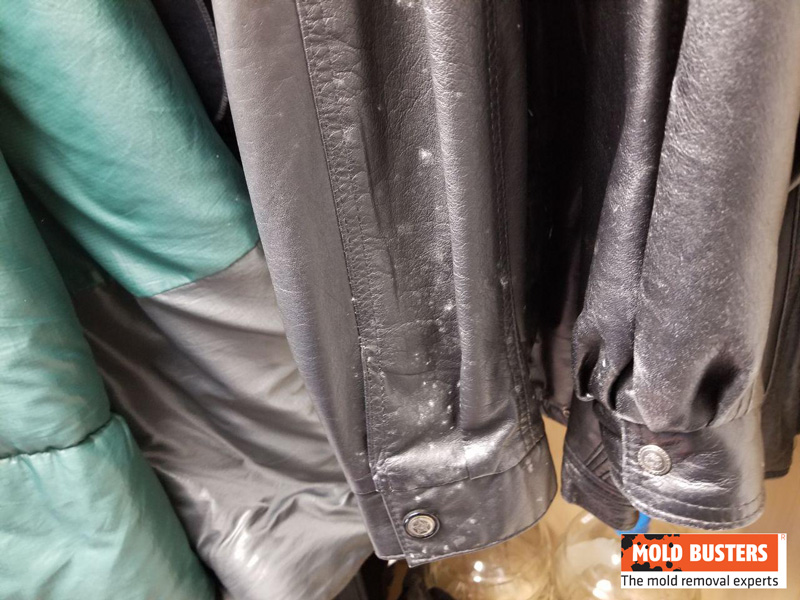
Visual comparison of mildew vs mold on clothing fabrics
Is Mold on Clothes Dangerous to Your Health?
Yes, mold on clothes poses significant health dangers including respiratory complications, skin reactions, and immune system suppression. Professional health risk assessment considers mold type, exposure duration, and individual sensitivity factors.
Immediate Health Effects
⚠️ Immediate Symptoms from Wearing Moldy Clothes
Wearing moldy clothes can trigger immediate allergic reactions including skin irritation, respiratory distress, and eye irritation. Common immediate symptoms include:
- Respiratory symptoms: Coughing, sneezing, wheezing, throat irritation
- Skin reactions: Rashes, itching, contact dermatitis, hives
- Eye irritation: Watery eyes, redness, burning sensation
- Nasal symptoms: Congestion, runny nose, postnasal drip
- General discomfort: Headaches, fatigue, dizziness
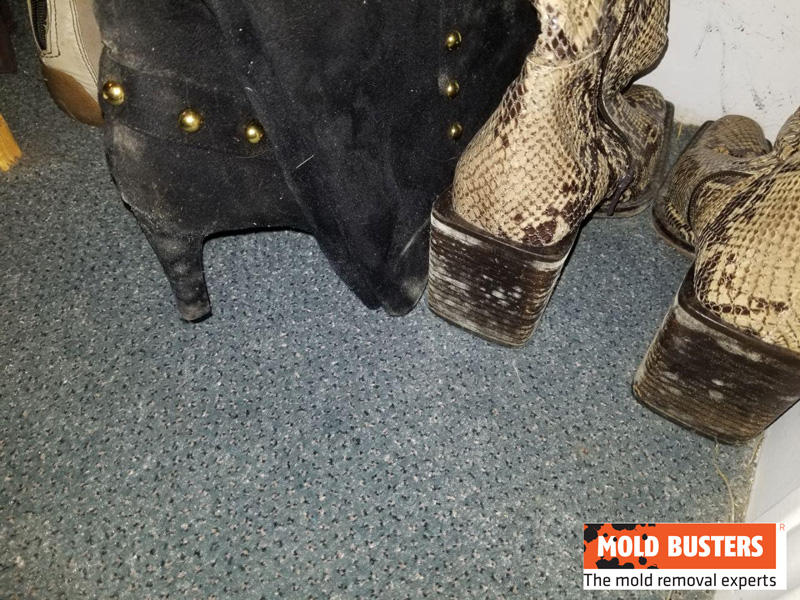
Health risks associated with mold exposure on clothing and shoes
Long-Term Health Risks
🔄 Chronic Health Conditions
Prolonged exposure to moldy clothes can cause chronic health conditions including immune system weakening, persistent respiratory problems, and increased infection susceptibility. Long-term risks include:
- Immune system compromise: Reduced ability to fight infections
- Chronic respiratory conditions: Persistent asthma, bronchitis
- Allergic sensitization: Developing new allergies to mold species
- Neurological effects: Memory problems, concentration difficulties
⚫ Black Mold Dangers
Black mold on clothes poses the highest health risk due to mycotoxin production that can cause severe respiratory problems, neurological symptoms, and immune system suppression. Professional assessment and immediate removal are essential for black mold contamination.
🧺 Post-Washing Risks
Mold stains remaining after washing indicate incomplete spore removal and continued health risk potential. Persistent stains suggest deep fabric penetration requiring stronger treatment methods or professional cleaning services.
👶 Baby Clothes Risks
Mold on baby clothes poses heightened risks due to infants’ developing immune systems and sensitive skin. Immediate replacement rather than cleaning is recommended for any moldy baby clothing or bedding items.
🛁 Towel Mold Dangers
Mold on towels creates higher exposure risk due to direct face and body contact during use. Bathroom mold issues often contribute to towel contamination requiring comprehensive treatment approaches.
Should You Throw Out Moldy Clothes?
Professional assessment determines whether moldy clothes can be salvaged through cleaning or require disposal for health protection. Decision factors include mold type, contamination extent, fabric value, and individual health considerations.
When to Dispose of Moldy Clothes
🗑️ Immediate Disposal Required
Throw out moldy clothes when contamination exceeds 50% coverage, black mold is present, persistent odors remain after cleaning, or structural fabric damage occurs. Immediate disposal situations include:
- Extensive mold coverage: More than half the garment affected
- Black mold presence: Any Stachybotrys chartarum contamination
- Persistent musty odors: Smell remains after multiple cleaning attempts
- Fabric deterioration: Holes, weakness, or structural damage
- High-risk individuals: Items for babies, elderly, or immunocompromised people
- Delicate fabrics: Silk, vintage, or irreplaceable items that can’t withstand aggressive cleaning
✅ When Cleaning is Possible
Moldy clothes can often be saved when mold coverage is minimal, contamination is recent (under 48 hours), synthetic fabrics resist deep penetration, and no structural damage exists.
🔬 Professional Assessment
Professional evaluation considers mold species identification, contamination depth, fabric type, and health risk factors to determine optimal treatment approaches. Professional mold testing provides accurate contamination assessment.
🛡️ Safe Disposal Protocol
Safe moldy clothing disposal requires sealed plastic bags to prevent spore spread, immediate removal from living areas, and proper waste handling protocols to protect family health.
Can You Put Moldy Clothes in the Washing Machine?
Yes, you can wash moldy clothes in your washing machine with proper precautions including pre-treatment, hot water cycles, mold-killing additives, and post-wash machine cleaning. Safety protocols prevent cross-contamination and ensure effective spore elimination.
🧽 Pre-Treatment Steps
Pre-treat moldy clothes by brushing off loose spores outdoors, applying mold-killing solutions directly to stains, and isolating contaminated items to prevent spread. Pre-treatment steps include:
- Outdoor preparation: Remove loose spores away from living areas
- Direct application: Apply vinegar or hydrogen peroxide to visible mold
- Soaking period: Allow pre-treatment to penetrate for 30-60 minutes
- Isolation protocol: Store treated items in sealed bags until washing
⚙️ Optimal Washing Settings
Use the hottest water temperature safe for the fabric combined with extended wash cycles and additional rinse cycles to maximize mold spore elimination. Optimal settings include:
- Water temperature: Hottest setting fabric can tolerate (140°F minimum)
- Cycle length: Extended or heavy-duty wash cycles
- Rinse cycles: Additional rinse to remove dead spores and residues
- Load size: Small loads allow better agitation and penetration
🧴 Mold-Killing Additives
Add mold-killing agents like white vinegar, borax, or hydrogen peroxide to enhance cleaning effectiveness beyond standard detergent. Recommended additives include:
- White vinegar: 1 cup per load kills 82% of mold species
- Borax: 1/2 cup dissolved in hot water prevents future growth
- Hydrogen peroxide: 1/2 cup for bleach-safe fabrics
- Baking soda: 1/2 cup for odor elimination and pH balance
🧼 Post-Wash Machine Cleaning
Run an empty hot water cycle with 2 cups white vinegar followed by a baking soda cycle to eliminate residual spores and prevent cross-contamination to future loads.
How to Get Mold Out of Clothes: Professional Removal Methods
Professional mold removal from clothes requires systematic approaches based on mold type, fabric material, and contamination severity. Mold Busters’ certified technicians have developed proven protocols through thousands of successful remediation projects.
⚪ White Mold Treatment
White mold responds best to vinegar treatment combined with hot water washing. The acetic acid in vinegar penetrates fabric fibers and neutralizes alkaline conditions that support mold growth.
⚫ Black Mold Treatment
Black mold removal requires professional-grade treatment due to toxicity concerns and deep fabric penetration. Professional removal methods include:
- Isolation protocols: Prevent spore spread during treatment
- Specialized cleaning agents: EPA-approved antimicrobial solutions
- Professional assessment: Determine if fabric can be safely cleaned
- Health monitoring: Ensure safe exposure levels during treatment
Treatment Method Comparison
| Treatment Method | Effectiveness | Application Steps | Best For |
|---|---|---|---|
| 🍋 White Vinegar Solution | 82% elimination |
|
Natural fibers, light to moderate mold |
| 🧂 Borax Treatment | 95% elimination + prevention |
|
Stubborn mold, white fabrics |
| 🧪 Hydrogen Peroxide | 99% elimination |
|
Colorfast fabrics, severe contamination |
| 👨🔬 Professional Cleaning | 99.9% guarantee |
|
Valuable items, extensive contamination |
Fabric-Specific Treatment Approaches
🌱 Cotton & Natural Fibers
Cotton and natural fibers respond well to vinegar treatments with hot water washing and sun drying for natural antimicrobial action. These fibers absorb treatments effectively but may require multiple cleaning cycles.
🧪 Synthetic Fabrics
Synthetic fabrics resist deep mold penetration making standard detergent with hydrogen peroxide effective for surface contamination. Medium to hot water temperatures prevent fabric damage while ensuring spore elimination.
🪶 Delicate Fabric Care
Delicate fabrics like silk and wool require professional dry cleaning services specializing in mold remediation to prevent fabric damage while ensuring health safety.
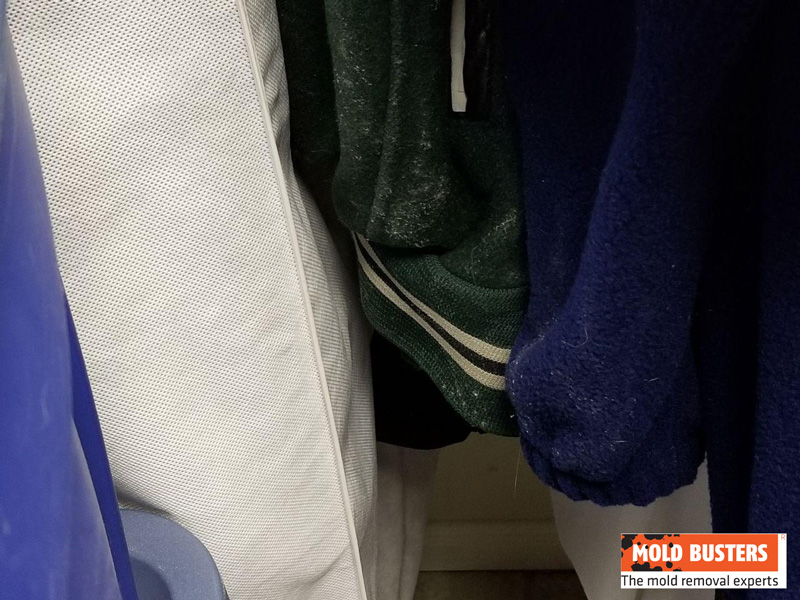
Professional mold removal process demonstration
How to Get Mildew Smell Out of Clothes
Eliminating mildew odor from clothes requires understanding odor source mechanisms and applying targeted treatment approaches. Professional odor elimination addresses both surface contamination and deep fiber penetration issues.
🤔 Why Odors Persist
Persistent musty odors indicate incomplete mold spore removal or continued moisture retention in fabric fibers. Common causes include insufficient water temperature, inadequate drying, or deeper contamination requiring specialized odor removal techniques.
👨⚕️ Professional Treatment
Professional odor removal becomes necessary when standard methods fail after multiple attempts, indicating deep contamination or multiple mold species presence requiring specialized treatment protocols.
🌿 Natural Odor Elimination Methods
Natural odor elimination combines enzyme action with pH balance restoration using household products that break down organic compounds producing musty smells.
- Baking soda pre-treatment: Absorbs odors and neutralizes pH
- Vinegar rinse: Breaks down alkaline odor compounds
- Sunlight exposure: UV radiation eliminates remaining spores
- Fresh air circulation: Natural deodorizing through oxidation
How to Prevent Mold Growing on Clothes
Effective mold prevention on clothes requires understanding moisture control, proper storage techniques, and environmental management. Professional prevention strategies developed through extensive remediation experience provide long-term protection.
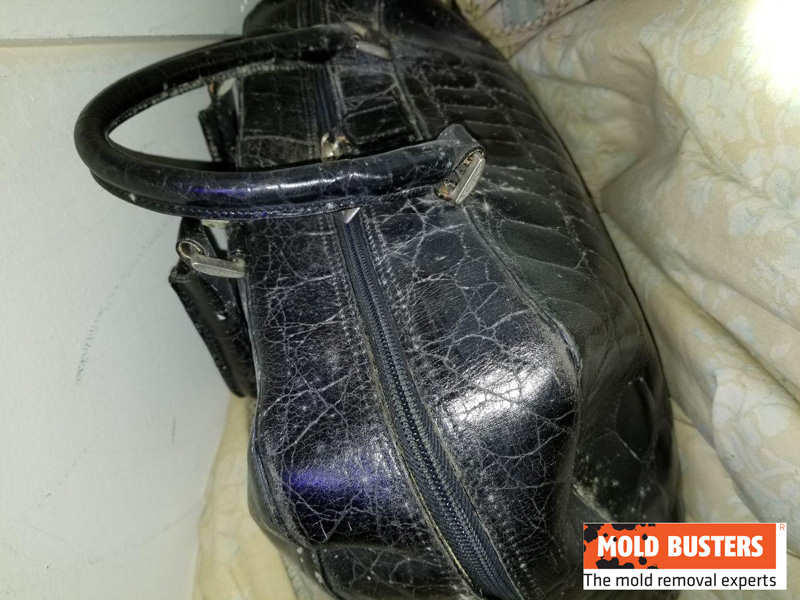
Professional storage techniques for mold prevention
⚡ Immediate Prevention Actions
Never store damp clothes and ensure complete drying before storage to eliminate the primary moisture source supporting mold growth. Critical prevention actions include:
- Immediate drying: Wash and dry clothes promptly, never leave damp
- Complete drying verification: Ensure 100% moisture elimination before storage
- Prompt machine removal: Remove clothes from washing machine immediately after cycles
- Pre-storage cleaning: Remove body oils, dirt, and organic residues
📦 Best Storage Practices
Proper clothing storage requires breathable materials, adequate spacing, and humidity control to prevent moisture accumulation and maintain air circulation around stored garments.
- Breathable storage: Cotton garment bags instead of plastic containers
- Adequate spacing: Prevent overcrowding that restricts air circulation
- Humidity monitoring: Maintain storage area humidity below 50%
- Regular inspection: Monthly checks for early mold detection
- Natural deterrents: Cedar blocks or lavender sachets for mold prevention
🏠 Environmental Controls
Environmental mold prevention requires comprehensive humidity and ventilation management throughout living spaces, with special attention to high-risk areas like closets, basements, and bathrooms.
- Dehumidifier installation: Maintain household humidity below 50%
- Ventilation improvement: Install ventilation systems in closets and storage areas
- Air circulation: Use fans to prevent stagnant air conditions
- Water damage prevention: Address leaks and condensation immediately
🌿 Seasonal Prevention Strategies
Seasonal clothing mold prevention adapts to changing humidity and temperature conditions throughout the year, with specific strategies for high-risk periods.
- Summer humidity control: Increased air conditioning use and dehumidifier operation
- Winter condensation prevention: Adequate heating to prevent moisture buildup
- Spring/fall transitions: Deep closet cleaning and inspection during seasonal changeovers
- Storage rotation: Regular use and inspection of seasonal clothing items
When Do You Need Professional Mold Assessment?
Professional mold assessment becomes essential when DIY methods prove insufficient or health risks exceed acceptable levels. Certified mold specialists provide comprehensive evaluation and remediation strategies for complex contamination situations.
⚠️ Warning Signs Requiring Professional Assessment
Extensive mold coverage, recurring contamination, or health symptom development indicate professional assessment requirements. Warning signs include:
- Multiple garment contamination: Mold affecting numerous clothing items
- Recurring mold problems: Contamination returns after cleaning attempts
- Health symptom development: Family members experiencing mold-related health issues
- Unknown mold species: Uncertainty about contamination type and toxicity
- Structural concerns: Visible mold in walls, ceilings, or building materials
🔬 Professional Services Available
Comprehensive professional mold services include inspection, testing, remediation, and prevention to address both immediate contamination and underlying causes.
- Professional mold inspection: Comprehensive contamination assessment
- Air quality testing: Identify airborne spore concentrations
- Professional remediation: Complete contamination elimination
- Infrared inspection: Identify hidden moisture sources
🆚 Professional vs DIY
Professional assessment provides scientific analysis, specialized equipment, and certified expertise unavailable through DIY methods. Professional advantages include:
- Species identification: Laboratory analysis of specific mold types
- Contamination mapping: Precise extent and source identification
- Health risk assessment: Professional evaluation of exposure dangers
- Remediation planning: Customized treatment strategies for effective resolution
Frequently Asked Questions About Mold on Clothes
Mold spores can survive indefinitely on clothes in dormant state until favorable conditions trigger activation and growth. Spores remain viable through washing, drying, and storage until eliminated through proper treatment methods.
Yes, mold spores easily transfer on clothing between rooms and buildings, spreading contamination to new areas. This transportation mechanism requires careful handling of moldy clothes and thorough cleaning protocols.
Wearing moldy clothes can cause immediate allergic reactions and skin irritation while providing continued spore exposure that may trigger respiratory problems and immune system complications.
Direct sunlight’s UV radiation can kill surface mold spores while complete drying eliminates moisture needed for growth. However, deep fabric contamination may require additional treatment methods.
Proper washing with hot water and mold-killing additives eliminates most mold contamination, but severely contaminated items may require multiple treatment cycles or professional cleaning.
Yes, even slightly damp clothes can develop mold within 24-48 hours in warm, humid conditions. Complete drying is essential before storage to prevent contamination.
Professional mold testing services provide laboratory analysis of fabric samples to identify specific species and contamination levels for proper treatment planning.
Water temperatures above 140°F (60°C) effectively kill most mold species on clothing, though treatment effectiveness also depends on contact time and cleaning agent concentration.
High heat dryer settings above 140°F can kill mold spores, but deeply embedded contamination may survive standard drying cycles, requiring pre-treatment before machine drying.
Yes, always wash moldy clothes separately to prevent spore transfer to clean garments and reduce cross-contamination risk during the cleaning process.
Professional Mold Remediation Services
Mold Busters provides comprehensive clothing and textile mold remediation services throughout Ontario and Quebec, backed by over 15,000 successful inspections since 2005. Our certified specialists combine advanced technology with proven treatment protocols for effective contamination elimination.
🏆 Why Choose Professional Services?
Professional services provide guaranteed results with health safety protocols unavailable through DIY approaches. Benefits include accurate species identification, customized treatment plans, and follow-up verification testing.
📍 Service Areas
For residents in Montreal, Ottawa, and surrounding areas, professional mold inspection services provide immediate assessment and comprehensive remediation planning.
🏠 Protect Your Family’s Health
Mold on clothes represents a serious health hazard requiring immediate attention and proper treatment. Understanding identification methods, health risks, removal techniques, and prevention strategies protects your family’s well-being while preserving valuable clothing items.
Remember that visible mold on clothes often indicates larger environmental issues requiring comprehensive assessment. Professional evaluation identifies hidden contamination sources and provides effective long-term solutions.
Don’t compromise your health – if you suspect extensive mold contamination or experience recurring problems, contact certified professionals for complete assessment and remediation services.
✅ Certified Professionals
Over 15,000 inspections completed since 2005 with certified, experienced technicians
🔬 Advanced Technology
State-of-the-art equipment and proven treatment protocols for effective mold elimination
📋 Comprehensive Service
Complete assessment, remediation, and prevention strategies for long-term protection
🕐 24/7 Emergency Response
Same-day inspections and emergency response available throughout Ontario and Quebec

Get Special Gift: Industry-Standard Mold Removal Guidelines
Download the industry-standard guidelines that Mold Busters use in their own mold removal services, including news, tips and special offers:
"*" indicates required fields
Published: May 19, 2020 Updated: August 29, 2025

Written by:
John Ward
Account Executive
Mold Busters
Fact checked by:
Michael Golubev
CEO
Mold Busters
